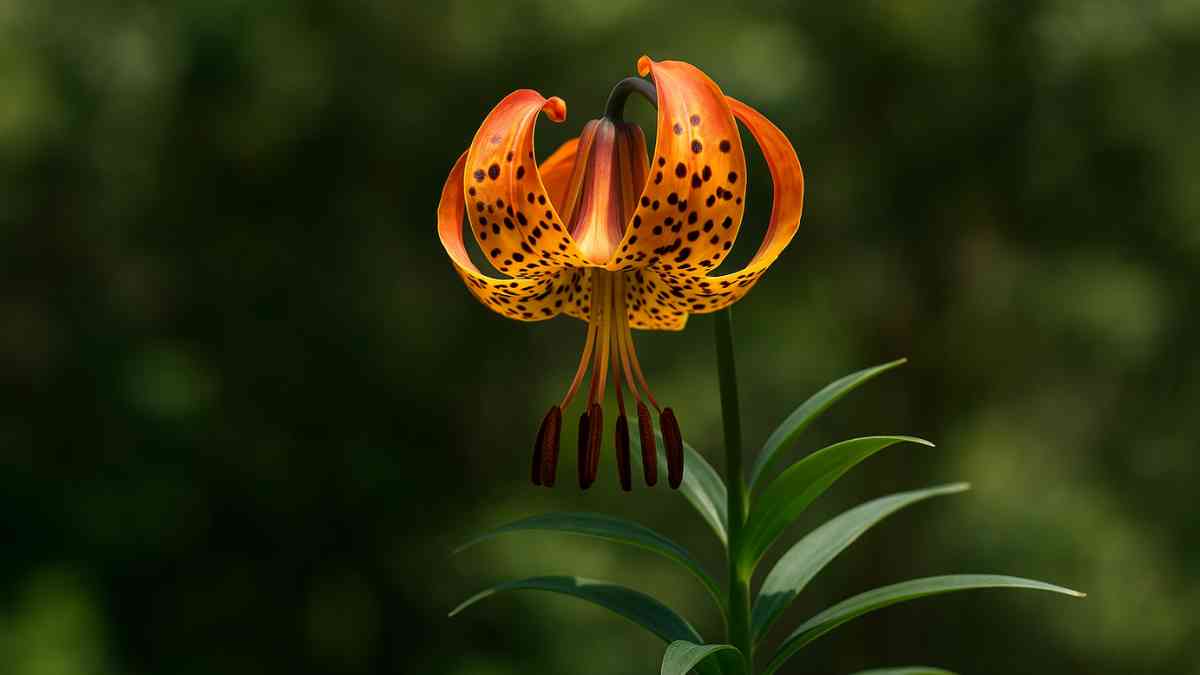
Among the dazzling flora that decorate the American West, the Leopard Lily (Lilium pardalinum) stands out with a fiery splash of orange-red petals, boldly spotted like the namesake wild cat. This captivating flower, native to the moist woodlands and meadows of California and Oregon, embodies wild elegance and resilience. Not just a visual delight, the leopard lily tells a story of adaptation, ecology, and understated charm.
Born from the Forests of the West
The leopard lily is indigenous to the western United States, flourishing in regions with cool, moist soil. It often grows near streams, shaded woodlands, and mountain meadows, where the environment supports its tall stems and clustered floral crowns. Unlike many lilies cultivated in manicured gardens, this one thrives in the wild, surviving fluctuating climates and growing in colonies through rhizomatous bulbs.
Recognizing Its Unique Appearance
With an average height ranging from 4 to 8 feet, the leopard lily is nothing short of statuesque. Each stem features whorled, lance-shaped leaves spiraling up toward Turk’s Cap-Shaped flowers that nod gently toward the ground. The blossoms, typically blooming from June through August, boast orange-red petals with brown or black spots fading into yellow at their centers. These distinctive markings give the flower its common name, creating a look that feels both exotic and untamed.
Ecological Significance in Its Native Habitat
This flower isn’t just pretty; it’s vital to its ecosystem. The leopard lily attracts a host of pollinators – including bees, butterflies, and, notably, hummingbirds – drawn by its vibrant color and nectar. These interactions support biodiversity, helping neighboring plants reproduce and stabilizing natural habitats. Moreover, its growth in colonies provides ground cover that helps prevent erosion and enriches the soil.
Cultural Value and Symbolism
While it may not feature heavily in folklore, the leopard lily has come to symbolize courage and fierce beauty due to its bold markings and hardy nature. Some gardeners and wildflower enthusiasts see it as a symbol of nature’s untamed spirit, a reminder of the balance between fragility and strength.
How to Grow It in a Home Garden
Despite its wild origin, the leopard lily can be cultivated in garden settings. For best results, choose moist, fertile, well-drained soil and a location with partial shade or filtered sunlight. In hot regions, afternoon shade is vital to prevent scorching.
Planting is typically done using bulbs, ideally in the fall, about 4 to 6 inches deep. Seeds are also an option, but they require patience and often take 2 to 4 years to flower. Once established, the plant requires regular watering, particularly in dry spells, though it does not tolerate waterlogged soil.
Minimal Maintenance with Maximum Impact
Once they find their footing, leopard lilies are relatively low-maintenance. They require little intervention beyond seasonal mulching and occasional division every few years to prevent overcrowding. However, watch for pests like aphids and fungal diseases in overly wet conditions.
Landscaping with Leopard Lilies
If you’re looking to add height, color, and natural texture to your garden, the leopard lily is a fantastic choice. It pairs beautifully with ferns, hostas, and other woodland plants, contributing to a layered and organic aesthetic. In wildflower gardens, it stands as a focal point, often surrounded by other native flora like columbine or goldenrod.
Rare Varieties and Subspecies
Several subspecies of leopard lily exist, including the Pitkin Marsh lily (Lilium pardalinum ssp. pitkinense), which is considered endangered. Found only in a few wetlands in Northern California, it faces threats from development, habitat drainage, and competition from invasive species. Conservationists are working to protect this delicate offshoot through habitat restoration and seed banking.
Fun Botanical Facts
- The plant’s spotted petals are believed to mimic animal camouflage, deterring some herbivores.
- Each flowering stem may hold up to 10 blooms at a time.
- Unlike most lilies, leopard lilies spread horizontally underground via rhizomes, forming colonies that can span several yards.
Physical Features and Botanical Profile
| Common Name | Leopard Lily |
|---|---|
| Scientific Name | Lilium pardalinum |
| Plant Type | Perennial, Rhizomatous |
| Height | 4 to 8 feet |
| Blooming Season | June to August |
| Flower Color | Orange-red with brown spots |
| Petal Shape | Turk’s cap (reflexed petals) |
| Native Region | California, Oregon (USA) |
| Sun Exposure | Partial shade to filtered sun |
| Water Needs | Medium to high |
| Soil Type | Moist, well-drained |
| Wildlife Attraction | Hummingbirds, Butterflies, Bees |
Social Media and Popularity
The leopard lily has gained subtle popularity on platforms like Instagram and Pinterest, particularly among native plant lovers, ecologists, and naturalistic garden designers. It often appears in photography accounts focusing on wildflowers, conservation, and the Pacific Northwest’s botanical life.
Gardeners sharing their growing journeys have noted the plant’s photogenic quality, especially when backlit in the morning sun. Despite its niche appeal, it has a growing fanbase that values it for more than just ornamental reasons.
No Known Celebrity or Public Figure Connection
Unlike trending houseplants or exotic hybrids, the leopard lily hasn’t been championed by celebrities or featured in high-fashion botanical sets. Yet, its raw, untamed beauty makes it a timeless presence in more grounded, authentic landscapes.
Is It Safe Around Pets?
As with many lilies, leopard lilies are toxic to cats. Ingestion can lead to kidney failure. If you’re a pet owner, it’s advisable to keep the plant out of reach or avoid planting it in areas accessible to curious animals.
Conservation Matters
While Lilium pardalinum itself is not broadly endangered, habitat destruction, water diversion, and invasive species continue to threaten its more vulnerable subspecies. Gardeners can support preservation by purchasing from ethical nurseries, avoiding wild harvesting, and contributing to native plant conservation efforts.
Conclusion
The leopard lily is more than a garden ornament – it’s a living emblem of nature’s artistry. With its striking appearance, ecological role, and adaptability, it proves that native plants can be both bold and beneficial. Whether you’re exploring a woodland trail or planning your next garden project, don’t overlook the wild beauty in full bloom that the leopard lily brings.
Explore your landscape with nature’s brushstrokes – plant a leopard lily and let the wild in.



